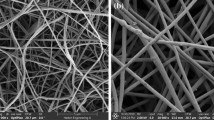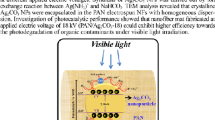Abstract
A novel approach for the electrospinning and functionalization of nanocatalyst-loaded polyvinylidene fluoride/polyacrylonitrile (PVDF/PAN) composite grafted with acrylic acid (AA; which form polyacrylic acid (PAA) brush) and decorated with silver (Ag/PAN/PVDF-g-PAA-TiO2/Fe–Pd) designed for the dechlorination and photodegradation of pesticides was carried out. PAN was used both as a nitrogen dopant as well as a co-polymer. Smooth nanofibers were obtained by electrospinning a solution of 12:2 wt.% PVDF/PAN blend using dimethylformamide (DMF) as solvent. The nanofibers were grafted with AA by free-radical polymerization using 2,2′azobis(2-methylpropionitrile) (AIBN) as initiator. Both bimetallic iron–palladium (Fe–Pd) and titania (TiO2) nanoparticles (NP) were anchored on the grafted nanofibers via the carboxylate groups by in situ and ex situ synthesis. The Fe–Pd and nitrogen-doped TiO2 nanoparticles were subsequently used for dechlorination and oxidation of target pollutants (dieldrin, chlorpyrifos, diuron, and fipronil) to benign products. Structural and chemical characterizations of the composites were done using various techniques. These include surface area and porosity analyzer (ASAP) using the technique by Brunner Emmett Teller (BET), Fourier transform infrared (FTIR), X-ray diffraction (XRD), scanning electron microscopy (SEM), and transmission electron microscope (TEM) analyses were done. After dechlorination, the transformation products (TPs) for dieldrin, chlorpyrifos, diuron, and fipronil were obtained and identified using two-dimensional gas chromatography (time-of-flight) with a mass spectrometer detector (GCxGC-TOFMS). Analysis of total organic carbon (TOC) was carried out and used to extrapolate percentage mineralization. Experimental results showed that dechlorination efficiencies of 96, 93, 96, and 90 % for 1, 2, 2, and 3 h treatment period were respectively achieved for 5 ppm solutions of dieldrin, chlorpyrifos, diuron, and fipronil. The dechlorination of dieldrin, diuron, and fipronil follows first-order kinetics while that of chlorpyrifos followed pseudo-first order. Mineralization performance of 34 to 45 % were recorded when Fe–Pd was used, however upon electrospinning, doping, and grafting (Ag/PAN/PVDF-g-PAA-TiO2/Fe–Pd composite); it significantly increased to 99.9999 %. This composite reveals great potential for dechlorination and mineralization of pesticides in contaminated water.













Similar content being viewed by others
References
Cardeal ZL, Souza AG and Amorim LCA (2011) Analytical methods for performing pesticide degradation studies in environmental samples. In: M Stoytcheva (ed) Pesticides-formulations, effects, fate. ISBN: 978-953-307-532-7
Chen X, Mao S (2007) Titanium dioxide nanomaterials: synthesis, properties, modifications, and applications. Chem Rev 107:2891–2959
Chutima S, Voraluck P, Narupol I (2011) The potential use of nano silver-decorated titanium dioxide nanofibers for toxin decomposition with antimicrobial and self-cleaning properties. Appl Surf Sci 257:8850–8856
Deniz AE, Celebioglu A, Kayaci F, Uyar T (2011) Electrospun polymeric composites containing TiO2 short nanofibers. Mater Chem Phys 129:701–704
Desai K, Kit K (2008) Effect of spinning temperature and blend ratios on electrospunchitosan/poly (acrylamide) blends fibers. Polymer 49:4046–4050
Duruibe JO, Ogwuegbu MOC, Egwurugwu JN (2007) Heavy metal pollution and human biotoxic effects. International Journal of Physical Sciences 2(5):112–118.
Han Y, Zhou J, Wang W, Wan H, Xu Z, Zheng S, Zhu D (2012) Enhanced selective hydrodechlorination of 1,2-dichloroethane to ethylene on Pt-Ag/TiO2 catalysts prepared by sequential photodeposition. Appl Catal B: Environ
Homayoni H, Ravandi SAH, Valizadeh M (2009) Electrospinning of chitosan nanofibers: processing optimization. Carbohydr Polym 77:659–661
Huang Y, Liu S, Lin Z, Li W, Li X, Cao. R (2012) Facile synthesis of palladium nanoparticles encapsulated in amine-functionalized mesoporous metal–organic frameworks and catalytic for dehalogenation. J Catal New York 292:111–117
Ignatova M, Starbova K, Markova NM, Rashkov I (2006) Electrospunnano fibre mats with antibacterial properties from quaternised chitosan and polyvinyl alcohol. Carbohydr Res 341:2098–2107
Im JS, Kim MI, Lee YS (2008) Preparation of PAN based electrospun nanofiber web containing TiO2 for photocatalytic degradation. Mater Lett 62:3652–3655
Jaworek A, Krupa A, Lackowski M, Sobczyk AT, Czech T, Ramakrishna S, Sundarrajan S, Pliszka D (2009) Nanocomposite fabric formation by electrospinning and electrospraying technologies. J Electrost 67:435–438
Kang R, Ouyang X, Han J, Zheh X (2001) A novel silica-polyglycol supported polymer anchored bimetallic palladium-based catalyst for dechlorination of aromatic chlorides in water. J Mol Catal A Chem 175(1–2):153–159
Kedziora A, Strek W, Kepinski L, Bugla-plosnska G, Doroszkiewicz W (2012) Synthesis and antibacterial activity of novel titanium dioxide doped with silver. J Sol Gel 62:79–86. doi:10.1007/s10971-012-2688-8
Li D, Xia Y (2004) Electrospinning of nanofibers: reinventing the wheel. Adv Mater 16(14):1151–1170
Li JH, Shao XS, Zhou Q, Li MZ, Zhang QQ (2013) The double effects of silver nanoparticles on the PVDF membrane: surface hydrophilicity and antifouling performance. Appl Surf Sci 265:663–670
Meshesha B (2009) Catalytic hydrodechlorination of 1, 2, 4-trichlorobenzene over Pd/Mg (Al)O catalysts. Appl Catal B Environ 87(1):70–77
Muftikian R, Nebesny K, Fernando Q, Korte N (1996) X-ray photoelectron spectra of the palladium-iron bimetallic surface used for the rapid dechlorination of chlorinated organic environmental contaminants. Environ Sci Technol 30:3593–3596
Mwangi IW, Ngila JC, Ndungu P, Kamau JN, Msagati TAM (2013) Immobilized Fe(III)-doped titanium dioxide for photodegradation of dissolved organic compounds in water. Environ Sci Pollut Res. doi:10.1007/s11356-013-1600-6
Nguyen HQ, Deng B (2012) Electrospinning and in situ nitrogen doping of TiO2/PANnanofibers with photocatalytic activation in visible light. Mater Lett 82:102–104
Nthumbi RM, Ngila JC, Moodley B, Petrik L (2011) Method development for flow adsorption and removal of lead and copper in contaminated water using electrospun nanofibers of chitosan blend. Anal Lett 44(11):1937–1955
Nthumbi RM, Ngila JC, Moodley B, Kindness A, Petrik L (2012) ApplicationChitosan /polyacrylamide nanofibres for removal of chromate and phosphate in water. Phy Chem Earth 50–52:243–251
Nthumbi RM, Musyoka SM, Adelodun AA, Ngila JC (2016) Dechlorination of selected pesticides in water using catalytic bimetallic (Fe-Pd) nanoparticles immobilized on MgAlO support. In: Ramasami P, Bhowon MG, Jhaumeer-Laulloo S, Wah HLK (eds) Crystallizing ideas—the role of chemistry. Springer, Germany Chapter 20
Park H, Park Y, Kim W, Choi W (2013) Surface modificationof TiO2 photocatalyst for environmental applications. J Photochem Photobiol C: Photochem Rev 15:1–20
Pradeep TA (2009) In: Savage N, Diallo M, Duncan J, Street A, Sustich R (eds) Nanotechnology applications for clean water. William Andrew Publication, USA
Pradeep T, Anshup (2009) Noble metal nanoparticles for water purification: A critical review. Thin Solid Films 517:6441–6478
Rodde RH, Einbu A, Varum KM (2008) A seasonal study of the chemicalcomposition and chitin quality of shells obtained from northern shrimp (Pandalus borealis). Carbohydr Polym 71:388–393
Shen L, Bian X, Lu X, Shi L, Liu Z, Chen L, Hou Z, Fan K (2012) Preparation and characterization of ZNO/polyethersulfone (PES)hybrid membranes. Desalination 293:21–29
Sheng Z, Liu Y (2011) Effects of silver nanoparticles on wastewater biofilms. Water Res 45(18):6039–6050
Shukla G, Kumar A, Bhanti M, PE J, Taneja A (2006) Organochlorine pesticide contamination of ground water in the city of Hyderabad. Environ Int 32:244–247
Stefan MI, Williamson CT (2004) UV light-based applications. Advanced oxidation processes for water and wastewater treatment. IWA Publishing, London Chapter 3
Vijaya A, Madhavi V, Madhavi G, 2012. Remediation of chlorpyrifos contaminated soilsby laboratory synthesized zero valent nano iron (ZVNI) particles: effect of pH and aluminium salt. Inter J Chem Res 3(2)
Wei J, Xu X, Liu Y, Wang D (2006) Catalytic hydrodechlorination of 2,4 dichlorophenol over nanoscale Pd/Fe: reaction pathway and some experimental parameters. Water Res 40:348–354
World Health Organization (2000) WHO environmental health criteria no. 216. International Programme on Chemical Safety. Disinfectants and disinfectant by-products, Geneva
Xu J, Bhattacharya D (2007) Fe/Pd nanoparticle immobilization in microfiltration pores: synthesis, characterization and application in dechlorination of poly chlorinated biphenyls. Ind Eng Chem Res 46:2348–2359
Xu J, Zhang J, Gao W, Liang H, Wang H, Li J (2009) Preparation of chitosan/PLAblend micro/nanofibers by electrospinning. Mater Lett 63:658–660
Yin L, Niu J, Shen Z, Chen J (2010a) Mechanism of reductive decomposition of pentachlorophenol by Ti-doped β-Bi2O3 under visible light irradiation. Environ Sci Technol 44(14):5581–5586
Yin L, Shen J, Niu J, Chen J, Duan Y (2010b) Degradation of pentachlorophenol and 2,4-dichlorophenol by sequential visible-light driven photocatalysis and laccase catalysis. Environ Sci Technol 44(23):9117–9122
Acknowledgments
The authors are grateful to the Mintek for providing the bursary for RM Nthumbi, Water Research Commission, and the Centre for Nanomaterials Science Research for project funding. The analytical research group, Dr. P. Nomngongo and Dr. Adedeji Adelodun, are sincerely thanked for providing intellectual support during the course of this study.
Author information
Authors and Affiliations
Corresponding author
Additional information
Responsible editor: Santiago V. Luis
Rights and permissions
About this article
Cite this article
Nthumbi, R.M., Ngila, J.C. Electrospun and functionalized PVDF/PAN nanocatalyst-loaded composite for dechlorination and photodegradation of pesticides in contaminated water. Environ Sci Pollut Res 23, 20214–20231 (2016). https://doi.org/10.1007/s11356-016-7136-9
Received:
Accepted:
Published:
Issue Date:
DOI: https://doi.org/10.1007/s11356-016-7136-9




